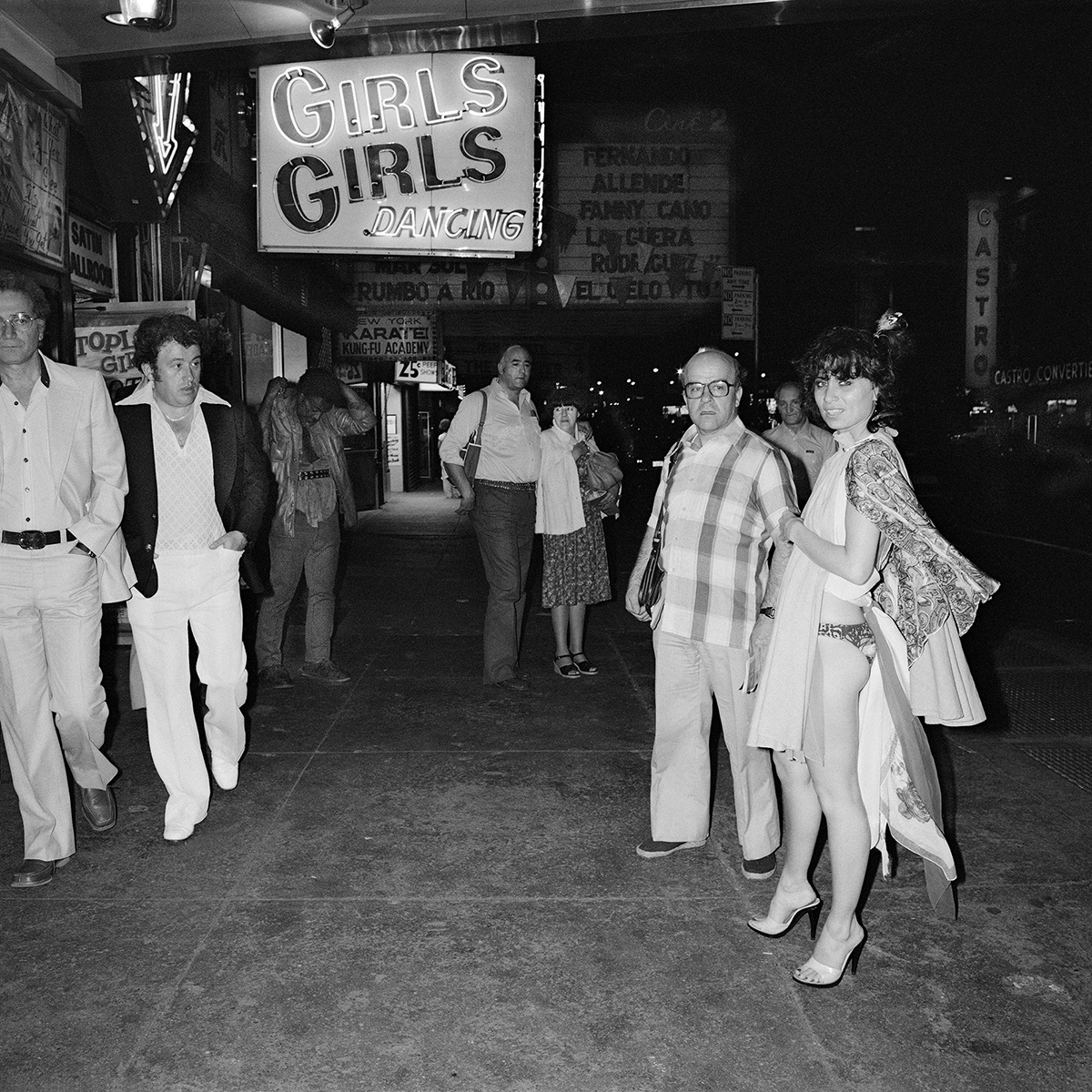Heady nights working in '70s New York go-go bars
- Text by Miss Rosen
- Photography by Meryl Meisler / ClampArt

In spring 1978, photographer Meryl Meisler accompanied her friend Judi Jupiter to an interview to work the bar at the Playmate, a new go-go bar opening on 49th Street and Broadway in New York.
“It was a topless-bottomless bar,” Meisler remembers. “There was disco music playing and girls were dancing on stage. It was fascinating. I asked if I could get a job there as a hostess, and was hired.”
During the late 1970s, Meisler led a double life. By day she worked as a CETA photographer documenting Jewish New York for the American Jewish Congress, exploring her heritage. By night, she was partying at nightclubs like Studio 54 and working at the Playmate, where she soon began making photographs, a selection of which have been published in Purgatory & Paradise SASSY ‘70s Suburbia & The City (Bizarre).
Meisler was required to wear a bathing suit or leotard, stockings, high heels, and makeup, and as hostess, she’d greet customers at the door, seating them by the stage, and serving them $4 “near-beers,” as the bar didn’t have a liquor license. She received a dollar tip for every drink, plus a $10 tip whenever she brought customers to the back rooms for private time with dancers and a $40 bottle of “champagne” (Martinelli’s sparkling cider).
“From time to time, customers would want to spend time with me in the back room,” Meisler says. “I would talk to them and draw them in a little sketchbook I carried. Nobody ever asked for their money back but I never had repeat customers.”

Byron Gives Judi Jupiters Flowers and Lets Smoke out his Nostrils NY, 1978
That December, Meisler and Jupiter left the Playmate and started working at Winks, another midtown go-go bar. After work, they’d go out with all the dancers to the Brasserie, an all-night coffee shop, to catch up over French onion soup.
“One of the women supported herself through medical school, another was buying a house. There was a big range of people. Some had drug problems, some had boyfriend problems, some were supporting kids and other family members. You couldn’t pigeonhole anyone.”
In July 1979, Meisler moved on to a third bar, Magic Carpet, which was painted red and featured a “Sultan’s Chambers”, a massive fish tank, and a swinger’s club upstairs.
That September, Meisler began working as a schoolteacher for the New York City Department of Education. “I hadn’t gotten my paycheck yet, so I continued working on the weekends at Magic Carpet. By November, my money came in, but it wasn’t a lot, so I kept on working in the clubs.”
“By early 1980, I stopped because I knew it was not appropriate for a schoolteacher to waitress at go-go clubs,” Meisler says.
The bars were also getting raided, and people started getting arrested by undercover police. “There were signs that said ‘don’t talk about money’, because it could be construed as prostitution – some people were getting higher tips that way,” remembers Meisler. “When Tina Turner sang ‘Private Dancer,’ I understood that.”

Self-Portrait Playmate Hostess NY, 1978

Playmate Hostesses Dressing NY, 1978

Judi Jupiter, Playmate Bartender NY, 1978

BURLESK GIRLS GIRLS GIRLS Byron, Judi Jupiter and friends NY, 1978

Poochie Wears her Shell Belt to Dance at The Magic Carpet NY, 1979

Girls, Girls, Girls, Dancing with Judi Jupiter in Times Square NY, 1978
Discover more of Meryl Meisler’s work here.
Follow Miss Rosen on Twitter.
Enjoyed this article? Like Huck on Facebook or follow us on Twitter.
Latest on Huck

In the ’60s and ’70s, Greenwich Village was the musical heart of New York
Talkin’ Greenwich Village — Author David Browne’s new book takes readers into the neighbourhood’s creative heyday, where a generation of artists and poets including Bob Dylan, Billie Holliday and Dave Van Ronk cut their teeth.
Written by: Cyna Mirzai

How Labour Activism changed the landscape of post-war USA
American Job — A new exhibition revisits over 70 years of working class solidarity and struggle, its radical legacy, and the central role of photography throughout.
Written by: Miss Rosen

Analogue Appreciation: Emma-Jean Thackray
Weirdo — In an ever more digital, online world, we ask our favourite artists about their most cherished pieces of physical culture. Today, multi-instrumentalist and Brownswood affiliate Emma-Jean Thackray.
Written by: Emma-Jean Thackray

Meet the shop cats of Hong Kong’s Sheung Wan district
Feline good — Traditionally adopted to keep away rats from expensive produce, the feline guardians have become part of the central neighbourhood’s fabric. Erica’s online series captures the local celebrities.
Written by: Isaac Muk

How trans rights activism and sex workers’ solidarity emerged in the ’70s and ’80s
Shoulder to Shoulder — In this extract from writer Jake Hall’s new book, which deep dives into the history of queer activism and coalition, they explore how anti-TERF and anti-SWERF campaigning developed from the same cloth.
Written by: Jake Hall

A behind the scenes look at the atomic wedgie community
Stretched out — Benjamin Fredrickson’s new project and photobook ‘Wedgies’ queers a time-old bullying act by exploring its erotic, extreme potential.
Written by: Isaac Muk